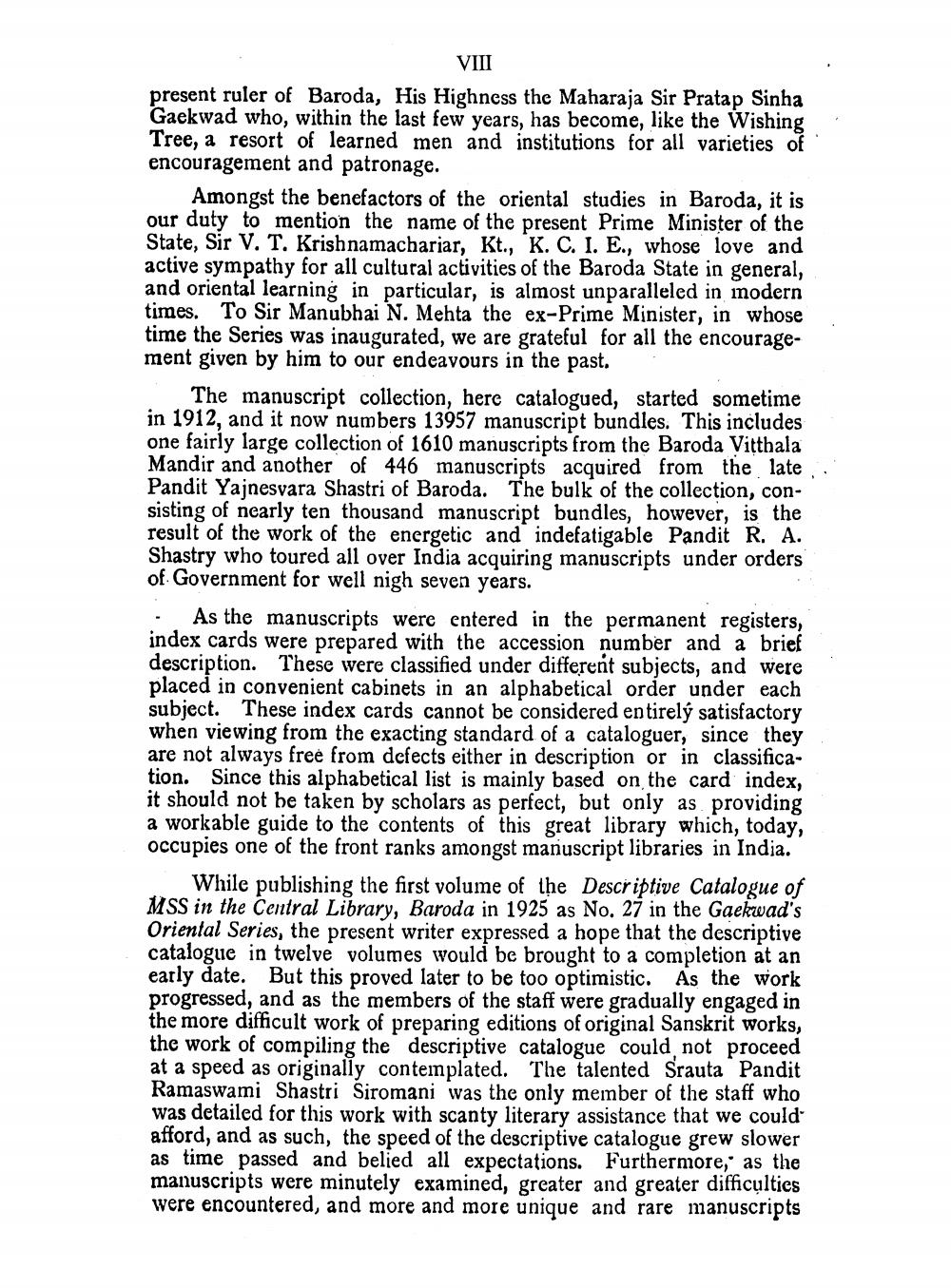Book Title: Alphabetical List of Manuscript in Oriental Institute Part 01 Author(s): Raghvan Nambiyar, Rajendra I Nanavati Publisher: Oriental Research Institute Vadodra View full book textPage 9
________________ VIII present ruler of Baroda, His Highness the Maharaja Sir Pratap Sinha Gaekwad who, within the last few years, has become, like the Wishing Tree, a resort of learned men and institutions for all varieties of encouragement and patronage. Amongst the benefactors of the oriental studies in Baroda, it is our duty to mention the name of the present Prime Minister of the State, Sir V. T. Krishnamachariar, Kt., K. C. I. E., whose love and active sympathy for all cultural activities of the Baroda State in general, and oriental learning in particular, is almost unparalleled in inodern times. To Sir Manubhai N. Mehta the ex-Prime Minister, in whose time the Series was inaugurated, we are grateful for all the encouragement given by him to our endeavours in the past. " The manuscript collection, here catalogued, started sometime in 1912, and it now numbers 13957 manuscript bundles. This includes one fairly large collection of 1610 manuscripts from the Baroda Vitthala Mandir and another of 446 manuscripts acquired from the late Pandit Yajnesvara Shastri of Baroda. The bulk of the collection, consisting of nearly ten thousand manuscript bundles, however, is the result of the work of the energetic and indefatigable Pandit R. A. Shastry who toured all over India acquiring manuscripts under orders of Government for well nigh seven years. . As the manuscripts were entered in the permanent registers, index cards were prepared with the accession number and a brief description. These were classified under different subjects, and were placed in convenient cabinets in an alphabetical order under each subject. These index cards cannot be considered entirely satisfactory when viewing from the exacting standard of a cataloguer, since they are not always free from defects either in description or in classification. Since this alphabetical list is mainly based on the card index, it should not be taken by scholars as perfect, but only as providing a workable guide to the contents of this great library which, today, occupies one of the front ranks amongst manuscript libraries in India. While publishing the first volume of the Descriptive Catalogue of MSS in the Central Library, Baroda in 1925 as No. 27 in the Gaekwad's Oriental Series, the present writer expressed a hope that the descriptive catalogue in twelve volumes would be brought to a completion at an early date. But this proved later to be too optimistic. As the work progressed, and as the members of the staff were gradually engaged in the more difficult work of preparing editions of original Sanskrit works, the work of compiling the descriptive catalogue could not proceed at a speed as originally contemplated. The talented Srauta Pandit Ramaswami Shastri Siromani was the only member of the staff who was detailed for this work with scanty literary assistance that we could afford, and as such, the speed of the descriptive catalogue grew slower as time passed and belied all expectations. Furthermore, as the manuscripts were minutely examined, greater and greater difficụlties were encountered, and more and more unique and rare manuscripts haberecht smber ot always free habetical list is maierfect, but only which, today,Page Navigation
1 ... 7 8 9 10 11 12 13 14 15 16 17 18 19 20 21 22 23 24 25 26 27 28 29 30 31 32 33 34 35 36 37 38 39 40 41 42 43 44 45 46 47 48 49 50 51 52 53 54 55 56 57 58 59 60 61 62 63 64 65 66 67 68 69 70 71 72 73 74 75 76 77 78 79 80 81 82 83 84 85 86 87 88 89 90 91 92 ... 756
